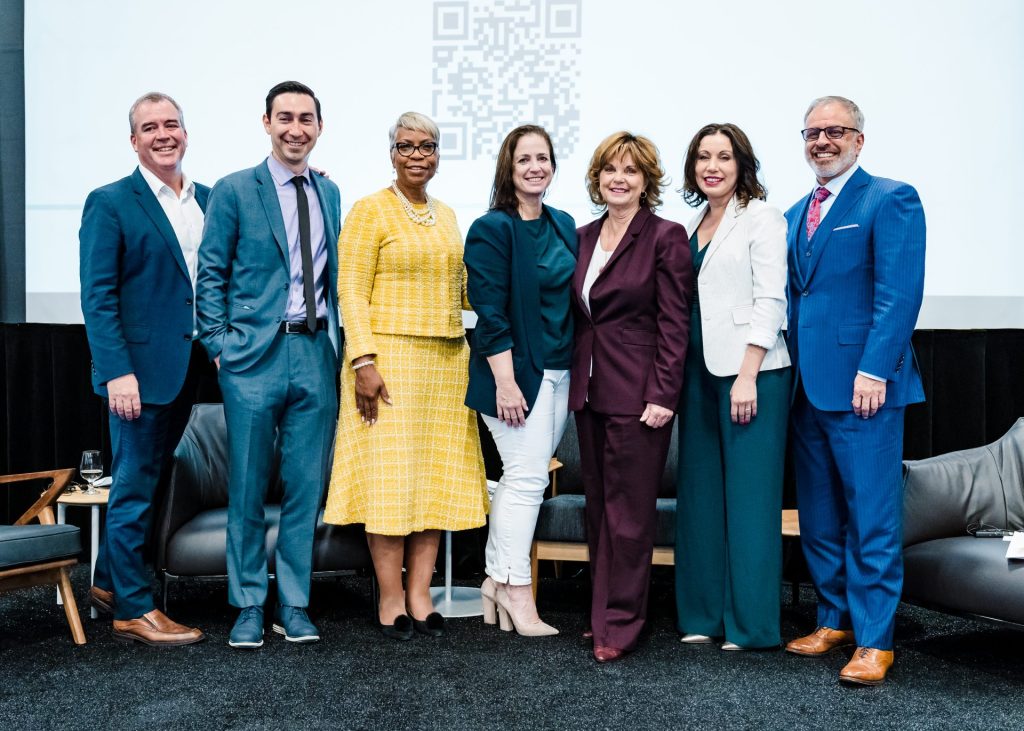County, City, academic, and private sector leaders announce commitment to inclusive economic growth
Today at its Report to the Community event, San Diego Regional EDC shared progress against the 2030 inclusive growth goals outlined pre-pandemic in 2018. With new data and bold objectives set around increasing the number of skilled talent, quality jobs, and thriving households critical to the region’s competitiveness, County and City of San Diego officials as well as leaders in the private sector, education, and philanthropy offered their shared commitments to economic inclusion.
 “EDC’s recent analysis underscores the significant impact of the pandemic on San Diego’s under-resourced communities and small businesses,” said Julian Parra, Business Banking Region Executive at Bank of America and EDC Board Chair. “To drive meaningful economic change, a diverse set of stakeholders must step up or the issues facing our economy—talent shortages, skills gaps, and a soaring cost of living—will further challenge San Diego’s economic competitiveness.”
“EDC’s recent analysis underscores the significant impact of the pandemic on San Diego’s under-resourced communities and small businesses,” said Julian Parra, Business Banking Region Executive at Bank of America and EDC Board Chair. “To drive meaningful economic change, a diverse set of stakeholders must step up or the issues facing our economy—talent shortages, skills gaps, and a soaring cost of living—will further challenge San Diego’s economic competitiveness.”
The innovation economy has made San Diego more prosperous than many of its peers—leading the region out of the COVID-spurred economic recession as it has in past downturns—but remains inaccessible to the fastest-growing segment of the region’s population. At no surprise, the goalposts EDC outlined four years ago are now farther from reach in the wake of the pandemic.
With nearly 200 members, EDC represents just a small fraction of the region’s employers. It is only with and through a broader group of stakeholders that more quality jobs, skilled talent, and thriving households in San Diego is possible. As such, EDC has enlisted the endorsement of key regional partners and employers that have committed to using the Inclusive Growth framework to inform their priorities, tactics, and resource allocation.
Hear some of those commitments:
“The County shares a deep commitment to the framework outlined by EDC. In order to help regionalize these Inclusive Growth goals, the County has created the Office of Economic Prosperity and Community Development that will prioritize significant investments in our communities as well as uplift our local businesses,” said Vice Chair Nora Vargas, San Diego County Board of Supervisors. “Our inclusive work is centered on achieving an equitable economic recovery that ensures prosperity for all San Diegans.”
 “Employing more than 1,200 San Diegans, we understand the criticality of large employers fostering a robust talent pipeline who can afford to live and thrive here,” said Jennie Brooks, Senior Vice President at Booz Allen Hamilton and EDC Vice Chair. “We are committed to advancing these goals by mentoring the next generation of women leaders through partnerships with local organizations like Girl Scouts San Diego; creating opportunities through our Mil/Tech Workforce Initiative to help military veterans build on their experiences and upskill into quality tech careers; and providing the flexibility that employees need in today’s dynamic work-life environment.”
“Employing more than 1,200 San Diegans, we understand the criticality of large employers fostering a robust talent pipeline who can afford to live and thrive here,” said Jennie Brooks, Senior Vice President at Booz Allen Hamilton and EDC Vice Chair. “We are committed to advancing these goals by mentoring the next generation of women leaders through partnerships with local organizations like Girl Scouts San Diego; creating opportunities through our Mil/Tech Workforce Initiative to help military veterans build on their experiences and upskill into quality tech careers; and providing the flexibility that employees need in today’s dynamic work-life environment.”
The pandemic’s impact to progress: Jobs, talent, households
In its new analysis, available at progress.inclusivesd.org, EDC quantifies the COVID-19 pandemic’s devastating impact on the regional economy and reports progress toward the 2030 goals. Takeaways include:
- QUALITY JOBS:
While the region saw an overall increase in the number of quality jobs* since 2017, the disparity between quality jobs in small and large firms grew. The jobs losses of 2020 were principally concentrated in lower paying jobs at small businesses, especially those held by people of color. Meanwhile, larger firms added quality jobs in haste. In order to compete on talent, small businesses need new, reliable customers. San Diego’s large buyers can support quality job growth and ensure supply chain resilience by spending more with small, local businesses.
- SKILLED TALENT:
Since 2016, all job growth has been in positions that require some form of degree or credential acquired through post-secondary education (PSE). Looking forward, it is projected that 84 percent of new jobs created between now and 2030 will also require PSE. Hispanics represent one-third of San Diego’s total population but only 15 percent of degree holders. Further, nearly half of middle school students are Hispanic but are statistically the least prepared for the jobs of the future. To address employers’ hiring challenges long-term, the region must invest in college readiness for more San Diego students.
- THRIVING HOUSEHOLDS:
Rapidly rising home prices—up more than 30 percent in the last two years alone—coupled with jobs losses have resulted in almost 11,000 fewer thriving households** in 2020 than in 2017. Further, the region lost 3,200 licensed childcare facilities due to business closures amid the pandemic. Rising costs and access to childcare, transportation, and broadband—disproportionately felt by people of color—will leave businesses unable to retain or recruit talent from outside of the region.
While the innovation cluster has more than rebounded from the pandemic, the talent challenges employers face will only worsen and threaten their growth across San Diego. A concerted commitment to Inclusive Growth must be made; the region’s competitiveness depends on it.
The initiative is sponsored by Bank of America, HomeFed Corporation, San Diego Gas & Electric, Southwest Airlines, The San Diego Foundation, University of San Diego School of Business, City of San Diego, and County of San Diego.
Read the full report at progress.inclusiveSD.org.
*Quality job = $44K wages + healthcare benefits.
**Thriving household = total income covers cost of living for renter- or owner-occupied households, at $79.6K and $122K respectively.